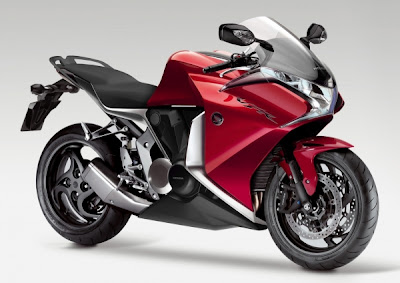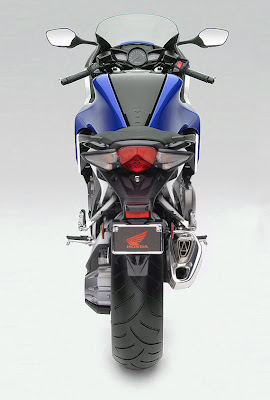The 2012 Honda VFR1200F unique bodywork fuses both the cowl and fairings together to create a single smooth, unified, aerodynamic surface. Also, note what you don't see: no visible fasteners break up the fairing's lines. This design also routes appropriate airflow in separate paths for both engine cooling and rider comfort. Honda VFR1200F available as an option to the standard six-speed manual model, our dual-clutch, automatic transmission allows push-button six-speed "paddle" shifting. You can also choose from two "automatic" modes (D-mode for regular operation and S-mode for sporty riding), and let the transmission shift for you. And for 2012 it's even better, with revised software to make it more user friendly: New software takes note of the way you ride and then optimizes the shift points.
The 2012 VFR1200F features increased fuel capacity, which, along with more efficient fuel management, results in a greater riding range. We told you the VFR's parts manifest reads almost like that of a factory road racer. Example: A trick slipper clutch mechanism that moderates the effect of deceleration torque on the rear wheel, allowing engine braking to slow the bike without causing the rear tire to chatter. Drawing on 30 years of V4 technology and racing success, Honda designers gave the VFR1200F what is surely the most advanced streetbike engine yet: a fuel-injected, liquid-cooled 1237cc, 76-degree, V4 brimming with low-end torque. Overall, it's more compact than the engine from the 781cc Interceptor. Updates for 2012 increase fuel economy and improves torque from 2000 to 4000 rpm.
Compact engine size was critical, so our engineers placed the VFR1200F powerplant's V4 rear cylinders side by side but close together, while the front cylinders are more widely spaced. This makes the engine narrower near the rider's feet and allows the entire chassis and seating area to feature a distinctly narrowed profile. Honda VFR1200F inspired by our championship-winning CRF motocross machines, we used Honda's patented Unicam technology to minimize cylinder head size, weight, and allows for a flatter combustion chamber for a quicker, more efficient burn while still allowing an impressive redline of 10,200 rpm.
VFR1200F is available as an option to the standard six-speed manual model, our dual-clutch, automatic transmission allows push-button six-speed "paddle" shifting. You can also choose from two "automatic" modes (D-mode for regular operation and S-mode for sporty riding), and let the transmission shift for you. And for 2012 it's even better, with revised software to make it more user friendly: New software takes note of the way you ride and then optimizes the shift points.
The VFR1200F features Honda's Throttle-By-Wire system to ensure outstanding response and seamless acceleration across the engine's rev range. The Throttle-By-Wire system incorporates an Electronic Control Unit (ECU) to process information from the rider throttle control input and throttle valve position to return accurate throttle response. In addition to an already full-featured LCD/analog instrument package, we've added a trip computer that adds current MPG, average MPG, and miles-to-empty information.
The new seat for 2012 VFR1200F a supportive, vacuum-molded dual-seat design offers increased comfort for both the rider and passenger. It features a flat and expansive seating area, with the space to adopt a range of different seating positions. This improves comfort during long days on the road. And your passenger also gets easy-reach grab handles and comfortable footrests. The VFR's Combined Braking System (CBS) with ABS melds the benefits of Anti-Lock Braking (ABS) with the measured application of front brakes when the rear brake lever is used. During front brake lever activation, all the right-side caliper pistons are applied, along with four of the pistons on the left side. When the rear brake is applied, the other two left-side pistons are actuated. To maintain equal braking force when using just the front brake, the right-side pistons are slightly smaller than the left-side pistons.




















0 comments:
Post a Comment